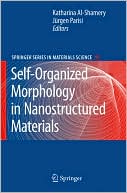Self-Organized Morphology in Nanostructured Materials
Search in google:
In this volume, concepts of nonlinear dynamics and self-organization are applied to topics in materials sciences with emphasis on semiconductors, soft matter, and biomaterials. The questions addressed include how to compare ordering phenomena under nonequilibrium situations, usually called self-organized structures, with those arising under situations close to equilibrium via selfassembly. Analogies are pointed out, differences are characterized, and efforts made to discover common features in the mechanistic description of those phenomena. Of major importance is the question of the role of spatial and temporal order, in particular, the application of concepts developed on macroscopic and microscopic scales to structure formation occurring on nanoscales, which occupies the focus of interest on the frontiers of science.
Organic Crystalline NanofibersIntroduction 1Growth of Ultrathin Films: Molecular Orientation Control 2Needle Films on Dedicated Templates: Mutual Orientation and Morphology Control of Nanoaggregates 6Plain Mica 6Au-Modified Mica 8Water-Treated Mica 9Selected Applications in Nano- and Microoptics 9Summary and Outlook: Future Devices From Organic Nanofibers 14References 15Titanium-Based Molecular Architectures Formed by Self-Assembled ReactionsIntroduction 17Results and Discussion 19Formation of Molecular Architectures 19Molecular Architectures Accompanied by Radical Induced C-C Coupling Reactions 33Molecular Architectures Based on C-C Coupling Reactions Initiated by C-H Bond Activation Reactions 38Conclusion and Future Directions 42References 43Self-Assemblies of Organic and Inorganic MaterialsIntroduction 47Structure of Colloidal Self-Assemblies Made of Surfactants and Used as Templates 49Production of Nanocrystals by Using Colloidal Solutions as Templates and Their Limitations 51Self-Organization of Nanocrystals 55ColloidalNanolithography by Using Nanocrystals Organized in a Given Structure as Masks [83] 61Conclusion 64References 64Self-Assembled Nanoparticle RingsIntroduction 67Experimental Formation of Nanoparticle Rings 68Spreading of Polymer Solution on Water Surface 68HDA Pancake Structures 69CoPt[subscript 3] Nanoparticle Rings 72Model for the Formation of HDA Pancakes 74Phase Separation of Binary Solution 74Rupture of Thin HDA Film into Micrometer-Size Pancakes 78Formation of a Nanoparticle Ring at the Edge of an HDA Pancake 81Pinning of an HDA Micrometer-Size Pancake 81Forces Acting on the Nanoparticle Located in the Interior of Pancake 82Forces Acting on the Nanoparticle Located at the Edge of Pancake 84Summary and Conclusions 85References 86Patterns of Nanodroplets: The Belousov-Zhabotinsky-Aerosol OT-Microemulsion SystemIntroduction 89The BZ-AOT System 90The BZ Reaction 90AOT Microemulsions 91The BZ-AOT System 93Experimental Results 94Experimental Configuration 94Turing Patterns 95Patterns Associated with a Fast-Diffusing Activator 97Complex Patterns - Dashes and Segments 100Localized Patterns 101Theoretical Considerations 103Constructing a Model 104Linear Stability Analysis and Types of Bifurcations 106Results of Numerical Simulations 108Conclusion and Future Directions 109References 112Honeycomb Carbon Networks: Preparation, Structure, and TransportIntroduction 115Experimental Formation of Polymer Honeycomb Structures 118Spreading of One Liquid on Another 118Production of Polymer Networks 119Structural Forms of Nitrocellulose Networks 120Structural Forms of Poly(p-phenylenevinylene) and Poly (3-octylthiophene) Networks 123Model for the Formation of Honeycomb Structures in Polymer Films 125Water Droplet on the Fluid Polymer Layer 125Nitrocellulose Networks as Precursor for Carbon Networks 132Temperature Dependence of Hopping Transport in Carbon Networks 133Electrical Field Dependence of Hopping Transport in Carbon Networks 142Summary and Conclusions 150References 151Chemical Waves in Living CellsIntroduction 155Waves of Metabolic Activity 156Calcium Signaling Waves 160Conclusions 164References 166Index 169








